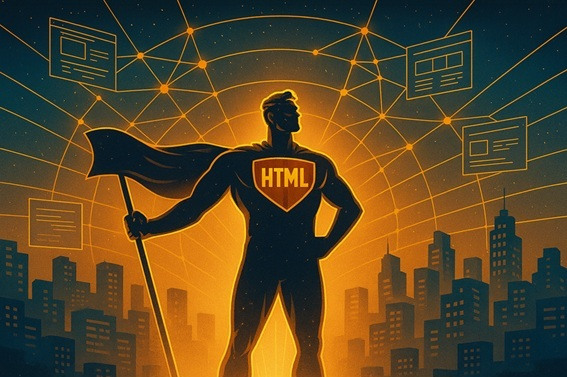In the Digital Publication Platforms course, we were introduced to HTML and learned how it continues to serve as a fundamental tool for building websites and organizing online content.
Introduction
In the late 1980s, Tim Berners-Lee introduced a revolutionary idea: using hypertext—texts with references (links) to other texts—to solve communication problems among researchers. This led to the creation of HyperText Markup Language (HTML), which enabled the birth of the World Wide Web, a turning point that redefined global communication and digital connectivity. This simple yet powerful language became a fundamental piece of the backbone of the web. Raw data was presented into readable pages, linked and easily navigable, giving rise to the World Wide Web as a public, interactive platform.
Since then, new versions of HTML have been implemented, but even after so many years, the language continues to be essential on the internet. In fact, every single website relies on it. While technology has advanced rapidly, one question persists:
Is HTML still worth learning in 2025?
The answer is a resounding "Yes!" HTML, combined with CSS (Cascading Style Sheets), forms the basis for creating functional and visually appealing websites. With its easy-to-learn syntax, HTML allows developers to define how a web page is structured. This is the necessary foundation before more complex technologies are learned.
Five Reasons to Learn HTML
1. Customization: While HTML provides the structural framework of a webpage, defining elements such as headings, paragraphs, links, and multimedia, CSS customizes the layout, style, and overall visual presentation. Working together, they enable developers to create websites that reflect the desired design and functionality, which is usually not achievable with pre-built website templates.
2. Troubleshooting: Mastering HTML helps identify problems and implement solutions when issues appear on a page. Fixing broken links, correcting display issues, or optimizing page load times can be easily handled.
3. SEO (Search Engine Optimization): Semantic tags (e.g. <h1>) provide information to search engines, which improve the website's visibility and ranking in search results.
4. Communication: HTML bridges the gap between designers, editors and developers. It empowers non-developers to communicate their needs effectively and fosters better collaboration in project teams.
5. Accessibility: By using semantic HTML tags properly, content can be made accessible to all users, including those with disabilities, allowing easier navigation with assistive technologies like screen readers.
Is HTML Threatened by New Tools?
Over the years, the internet has evolved rapidly to meet the changing demands of the web. Tools and platforms like Drag-and-Drop Builders, Content Management Systems (CMS) and Static Site Generators (SSGs) have simplified website creation. However, these tools don’t replace HTML - they rely on it.
Here’s why:
- Static Site Generators (SSGs): These tools create static HTML sites. The very purpose of an SSG is to produce HTML files that browsers can render.
- Content Management Systems (CMS): CMS platforms generate dynamic HTML sites, enabling users to manage content easily while relying on HTML for structure and functionality.
- WYSIWYG Builders: Even though these builders often produce cluttered HTML, the output is still HTML.
The real question isn’t whether HTML is worth using, it's whether learning to write HTML properly is still relevant. The answer is a definitive yes. To create high-quality websites that excel in SEO and accessibility, a solid understanding of HTML is non-negotiable.
New tools enhance web development, but they are not a replacement for understanding HTML. Instead, they amplify its importance by requiring developers to have a strong grip of the fundamentals to optimize output and improve quality.
HTML 5 and Beyond
The fifth version of the markup language was more than just an update; it brought richer features and improved capabilities when it comes to work with web development. New semantic elements made it easier for search engines to better understand the structure and content of pages; external plugins were no longer necessary to embed multimedia elements on sites; enhancements in the use of graphics and visual effects were notable; this version contributed to improve cross-browser compatibility; and numerous other enhancements. The list of benefits and improvements brought by HTML5 is huge.
In 2017 HTML5.2 was released, making specification adjustments and new features, aiming to improve the language’s usability and interoperability.
But the real milestone came in 2019, when the World Wide Web Consortium (W3C) and the Web Hypertext Application Technology Working Group (WHATWG) signed the HTML Living Standard agreement, a decision to continuously update the tool with new features and improvements, rather than releasing new versions.
Conclusion: The Timeless Hero
Technology evolves as fast as the needs and expectations of web users and developers rise. Yet, HTML remains steadfast as the foundation of web development. It has supported the creation of accessible, efficient, and user-friendly digital experiences for decades. Learning HTML isn’t just a step into web development; it's a commitment to building the internet’s future with quality and purpose.
For anyone dealing with online content, understanding HTML is essential. It empowers individuals to control digital presentation, customization, and functionality, ensuring material is versatile and effective across platforms. High-quality websites, especially in terms of SEO and accessibility, require this foundational knowledge.
HTML is the timeless hero of the web. Those who master it hold the power to shape the digital content landscape for generations to come.
Where to go from here #
How to choose the right CMS for your content model
References #
Developer Indian. (n.d.). The history and evolution of HTML. https://www.developerindian.com/articles/the-history-and-evolution-of-html
Talent500. (2025). HTML vs HTML5: 2025 in-depth comparison & modern web guide. https://talent500.co/blog/html-vs-html5-2025-in-depth-comparison-modern-web-guide/
Open Journal Systems. (n.d.). How digital publishers benefit from HTML?. https://openjournalsystems.com/digital-publishers-benefit-html/
Good e-Reader. (n.d.). Feature: Are eBook apps, HTML5, or ePub3 the future of digital publishing?. https://goodereader.com/blog/electronic-readers/feature-are-ebook-apps-html5-or-epub3-the-future-of-digital-publishing
3D Issue. (n.d.). A tutorial in digital publishing with HTML5. https://www.3dissue.com/digital-publishing-with-html5/
Hasan, R. (2023, August 10). Why you should learn HTML: The backbone of web development. DEV Community. https://dev.to/ridoy_hasan/why-you-should-learn-html-the-backbone-of-web-development-206m
Mozilla Developer Network. (n.d.). HTML: HyperText Markup Language. https://developer.mozilla.org/docs/Web/HTML
Hostinger. (n.d.). What is HTML? Hypertext markup language basics for beginners. https://www.hostinger.com/tutorials/what-is-html
Digital Publication Platforms 2024/2025 by Manuel Matuzovic

